
China is rapidly expanding its naval capabilities, outpacing other nations with its impressive rate of shipbuilding. The People's Liberation Army Navy (PLAN) has become the world's largest navy by the number of vessels, although this metric does not fully capture its overall naval strength. Despite this, the PLAN's growth remains significant and noteworthy.
Thomas Shugart, Adjunct Senior Fellow at the Center for a New American Security, expressed concerns about China's approach. In a webinar hosted by the Brookings Institute on July 26, Shugart pointed out that while China aims to protect its regional waters and secure itself against potential threats, its methods appear coercive towards other countries. He cautioned that this aggressive posture might escalate tensions and lead to conflict.
Satellite imagery reveals China's extensive naval shipbuilding operations. At Huludao, China is constructing nuclear-powered submarines, including a new Type 093B attack submarine. Shugart noted the presence of several such submarines and possible components for the Type 095 class. At Dalian Shipyard, five Type 052DL destroyers are under construction, and Lushun Shipyard is working on a new advanced corvette. In Shanghai's Jiangmen Shipyard, five surface combatants are being built, with speculation that this site may be where China's next Type 004 aircraft carrier will be assembled.
Shugart highlighted China's dual-use shipyards, where civilian and naval vessels are built side by side. This practice, he noted, is partly funded by Western companies. He emphasized that China's ability to shift a versatile workforce between civilian and military shipbuilding could enhance its efficiency, potentially outpacing Western naval shipyards.
At Hudong Shipyard in Shanghai, Shugart observed the construction of three frigates and a Type 076 landing helicopter dock optimized for drone operations. He noted that this type of ship, equipped with a catapult for drones, is unique compared to US naval capabilities.
Emma Salisbury, a Seapower Research Fellow at the Council on Geostrategy in the UK, commented on the scale of China's shipbuilding efforts. She pointed out that no other country, including the US, builds multiple destroyers, frigates, and submarines simultaneously as China does. Salisbury also highlighted China's ambition to become a world-class military power by 2049, aiming to match or surpass the capabilities of major powers like the US.
China's naval strategy focuses on controlling the First Island Chain—a series of maritime barriers around its waters, including territories like Taiwan and the Senkaku Islands. Salisbury noted that control over these areas would help China secure its maritime interests and prevent external powers from challenging its access to the open sea.
The China Coast Guard, the world's largest maritime law enforcement fleet, plays a significant role alongside the PLAN. Salisbury emphasized the need to consider all maritime forces, including the Coast Guard and maritime militia, in assessing China's naval buildup. She also noted that China could potentially mobilize its civilian fleet for military purposes in a conflict.
China's shipbuilding output is substantial, with 42.3 million deadweight tons of merchant shipping completed last year alone. This total represents over half of global shipbuilding activity, showcasing China's dominance in the sector.
Bruce Jones, Director at the Brookings Institute, discussed the strategic implications of China's naval doctrine. He speculated about the possibility of a "mutually assured denial" scenario, where neither China nor the US can fully deny the other's naval operations. He highlighted the strategic importance of maintaining open sea lanes for global trade.
China's warships have traditionally been smaller than their American counterparts, but the gap is narrowing. Shugart predicted that by 2035, the PLAN could match the US Navy in terms of ship tonnage. He suggested that the US might need to explore alternative shipbuilding locations, such as Japan or South Korea, if its domestic capacity remains inadequate.
China lacks formal allies but has vassal states like Cambodia, where Chinese influence is evident. Shugart provided evidence of a large dry dock at Ream Naval Base in Cambodia, suggesting potential future use for Chinese submarines.
In conclusion, China's rapid naval expansion, including advances in submarine technology and the construction of new ship classes, reflects its growing maritime ambitions. While the US and its allies remain engaged in naval strategies and partnerships, China's approach to maritime power continues to evolve.